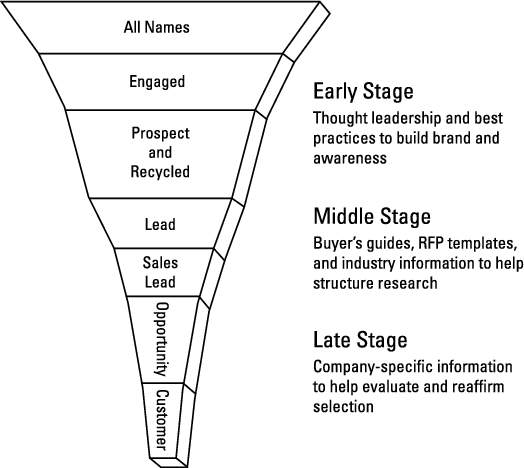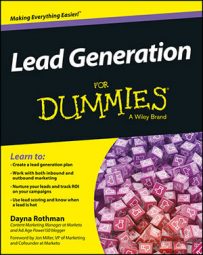Most companies typically define their buyer stages as early-, mid-, and late-stage buyers — or top-of-funnel (TOFU), middle-of-funnel (MOFU), and bottom-of-funnel (BOFU) buyers. Take a look at the following figure, which shows you how a sales funnel can map to buying stages.

Tailoring your sales programs and messages to this process, you can move leads down the funnel starting from the top of the funnel (early awareness) to the bottom of the funnel (late-stage buyers).
Early-stage buyers
Early-stage buyers often map to the awareness/friend, name, engaged, and target stages in your sales funnel. Early-stage buyers have either never heard about your company or have very little brand awareness. The goal of early-stage content assets and lead generation campaigns is to bring leads into your funnel and get them interested enough in what you are all about, so they want to stick around, consume more content through your lead nurture channels, and ultimately become customers.
The important thing to note at this stage when it comes to your lead generation campaigns is that you want to make sure you are tailoring your messaging for early-stage buyers. Someone who just learned about your company probably doesn't want to watch a customer testimonial. Instead, he is more interested in learning who you are and consuming thought leadership in the form of best practices.
Typically during this stage, buyers are either looking for general industry best practices and haven't realized they have a problem yet, or they realize they have a problem and are just starting their research. Your campaign messaging and offers must align with what a buyer is looking for in this stage. The idea is that through proper targeting and appropriate messaging, you can bring early-stage buyers into your funnel and help them move through their educational journey to become mid-stage buyers.
Mid-stage buyers
A buyer becomes mid-stage after she has shown some interest in your business's core competencies. That lead has displayed some sort of buying behavior and is potentially a true sales lead. A mid-stage buyer should map to the lead and sales lead stage of your sales funnel.
Whereas your early-stage offers and messaging often align to industry best practices and actionable tips, and have a focus on creating a relationship and trust with your buyer, your mid-stage offers are meant to direct your lead's focus towards your product.
If a lead sticks around, subscribes to your blog, downloads a variety of ebooks, and even attends a webinar, she is likely in the middle stages of your funnel. She has shown a real interest in your company and is ready to receive more targeted messaging and offers that tie in nicely with what your company can offer.
For example, consider a company that sells budgeting software to the enterprise. Maybe your early-stage offers discuss budgeting best practices, common budgeting pitfalls, how to optimize your budget, and so on. Then after a lead has shown interest, she is ready to receive offers that talk specifically about budgeting software. Notice how a buyer is moving from broad to specific interest in your product or service.
Late-stage buyers
Late-stage buyers are generally in the opportunity category and are getting pretty hyped up on your company's goods. They have successfully made it through your early-stage offers, have gone through the mid-stage gauntlet, and are now downloading very product-centric information such as pricing sheets, customer testimonial videos, and datasheets. Your early- and mid-stage offers have set the stage, and your leads now have a good understanding of how your product or service can cure their pain. Late-stage is a good time to be engaged with a sales person, as late-stage buyers are clear hand-raisers and have shown a solid interest in your company.

